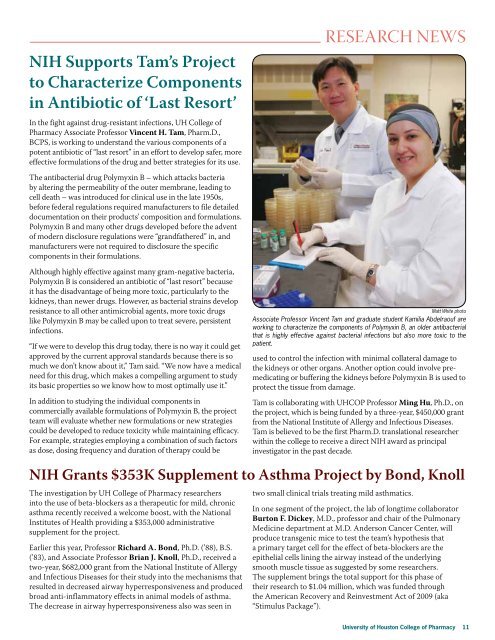University of Houston College of Pharmacy - the STEM Digital Village
University of Houston College of Pharmacy - the STEM Digital Village
University of Houston College of Pharmacy - the STEM Digital Village
You also want an ePaper? Increase the reach of your titles
YUMPU automatically turns print PDFs into web optimized ePapers that Google loves.
NIH Supports Tam’s Project<br />
to Characterize Components<br />
in Antibiotic <strong>of</strong> ‘Last Resort’<br />
In <strong>the</strong> fight against drug-resistant infections, UH <strong>College</strong> <strong>of</strong><br />
<strong>Pharmacy</strong> Associate Pr<strong>of</strong>essor Vincent H. Tam, Pharm.D.,<br />
BCPS, is working to understand <strong>the</strong> various components <strong>of</strong> a<br />
potent antibiotic <strong>of</strong> “last resort” in an effort to develop safer, more<br />
effective formulations <strong>of</strong> <strong>the</strong> drug and better strategies for its use.<br />
Research NEWS<br />
The antibacterial drug Polymyxin B – which attacks bacteria<br />
by altering <strong>the</strong> permeability <strong>of</strong> <strong>the</strong> outer membrane, leading to<br />
cell death – was introduced for clinical use in <strong>the</strong> late 1950s,<br />
before federal regulations required manufacturers to file detailed<br />
documentation on <strong>the</strong>ir products’ composition and formulations.<br />
Polymyxin B and many o<strong>the</strong>r drugs developed before <strong>the</strong> advent<br />
<strong>of</strong> modern disclosure regulations were “grandfa<strong>the</strong>red” in, and<br />
manufacturers were not required to disclosure <strong>the</strong> specific<br />
components in <strong>the</strong>ir formulations.<br />
Although highly effective against many gram-negative bacteria,<br />
Polymyxin B is considered an antibiotic <strong>of</strong> “last resort” because<br />
it has <strong>the</strong> disadvantage <strong>of</strong> being more toxic, particularly to <strong>the</strong><br />
kidneys, than newer drugs. However, as bacterial strains develop<br />
resistance to all o<strong>the</strong>r antimicrobial agents, more toxic drugs<br />
like Polymyxin B may be called upon to treat severe, persistent<br />
infections.<br />
“If we were to develop this drug today, <strong>the</strong>re is no way it could get<br />
approved by <strong>the</strong> current approval standards because <strong>the</strong>re is so<br />
much we don’t know about it,” Tam said. “We now have a medical<br />
need for this drug, which makes a compelling argument to study<br />
its basic properties so we know how to most optimally use it.”<br />
In addition to studying <strong>the</strong> individual components in<br />
commercially available formulations <strong>of</strong> Polymyxin B, <strong>the</strong> project<br />
team will evaluate whe<strong>the</strong>r new formulations or new strategies<br />
could be developed to reduce toxicity while maintaining efficacy.<br />
For example, strategies employing a combination <strong>of</strong> such factors<br />
as dose, dosing frequency and duration <strong>of</strong> <strong>the</strong>rapy could be<br />
Matt White photo<br />
Associate Pr<strong>of</strong>essor Vincent Tam and graduate student Kamilia Abdelraouf are<br />
working to characterize <strong>the</strong> components <strong>of</strong> Polymyxin B, an older antibacterial<br />
that is highly effective against bacterial infections but also more toxic to <strong>the</strong><br />
patient.<br />
used to control <strong>the</strong> infection with minimal collateral damage to<br />
<strong>the</strong> kidneys or o<strong>the</strong>r organs. Ano<strong>the</strong>r option could involve premedicating<br />
or buffering <strong>the</strong> kidneys before Polymyxin B is used to<br />
protect <strong>the</strong> tissue from damage.<br />
Tam is collaborating with UHCOP Pr<strong>of</strong>essor Ming Hu, Ph.D., on<br />
<strong>the</strong> project, which is being funded by a three-year, $450,000 grant<br />
from <strong>the</strong> National Institute <strong>of</strong> Allergy and Infectious Diseases.<br />
Tam is believed to be <strong>the</strong> first Pharm.D. translational researcher<br />
within <strong>the</strong> college to receive a direct NIH award as principal<br />
investigator in <strong>the</strong> past decade.<br />
NIH Grants $353K Supplement to Asthma Project by Bond, Knoll<br />
The investigation by UH <strong>College</strong> <strong>of</strong> <strong>Pharmacy</strong> researchers<br />
into <strong>the</strong> use <strong>of</strong> beta-blockers as a <strong>the</strong>rapeutic for mild, chronic<br />
asthma recently received a welcome boost, with <strong>the</strong> National<br />
Institutes <strong>of</strong> Health providing a $353,000 administrative<br />
supplement for <strong>the</strong> project.<br />
Earlier this year, Pr<strong>of</strong>essor Richard A. Bond, Ph.D. (’88), B.S.<br />
(’83), and Associate Pr<strong>of</strong>essor Brian J. Knoll, Ph.D., received a<br />
two-year, $682,000 grant from <strong>the</strong> National Institute <strong>of</strong> Allergy<br />
and Infectious Diseases for <strong>the</strong>ir study into <strong>the</strong> mechanisms that<br />
resulted in decreased airway hyperresponsiveness and produced<br />
broad anti-inflammatory effects in animal models <strong>of</strong> asthma.<br />
The decrease in airway hyperresponsiveness also was seen in<br />
two small clinical trials treating mild asthmatics.<br />
In one segment <strong>of</strong> <strong>the</strong> project, <strong>the</strong> lab <strong>of</strong> longtime collaborator<br />
Burton F. Dickey, M.D., pr<strong>of</strong>essor and chair <strong>of</strong> <strong>the</strong> Pulmonary<br />
Medicine department at M.D. Anderson Cancer Center, will<br />
produce transgenic mice to test <strong>the</strong> team’s hypo<strong>the</strong>sis that<br />
a primary target cell for <strong>the</strong> effect <strong>of</strong> beta-blockers are <strong>the</strong><br />
epi<strong>the</strong>lial cells lining <strong>the</strong> airway instead <strong>of</strong> <strong>the</strong> underlying<br />
smooth muscle tissue as suggested by some researchers.<br />
The supplement brings <strong>the</strong> total support for this phase <strong>of</strong><br />
<strong>the</strong>ir research to $1.04 million, which was funded through<br />
<strong>the</strong> American Recovery and Reinvestment Act <strong>of</strong> 2009 (aka<br />
“Stimulus Package”).<br />
<strong>University</strong> <strong>of</strong> <strong>Houston</strong> <strong>College</strong> <strong>of</strong> <strong>Pharmacy</strong> 11


